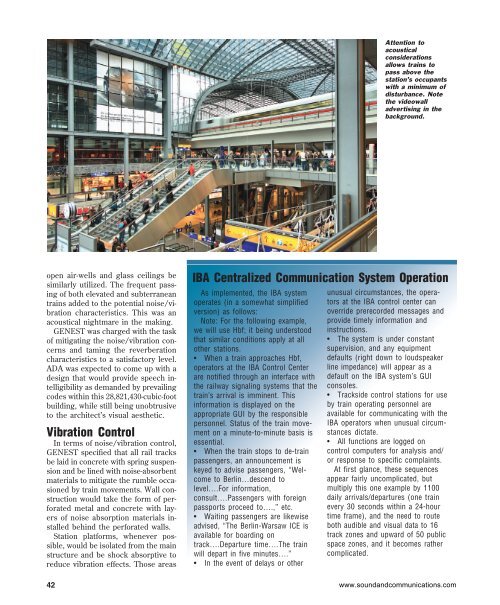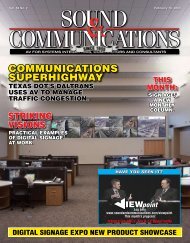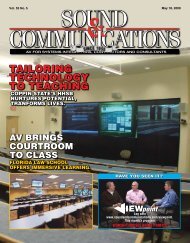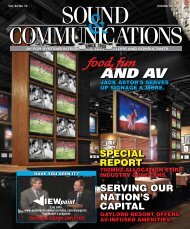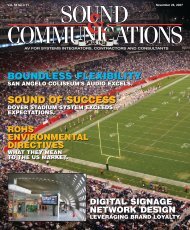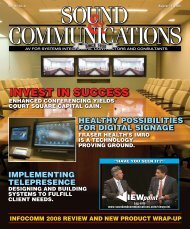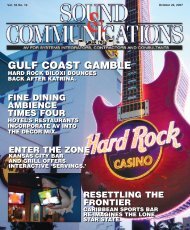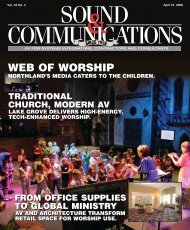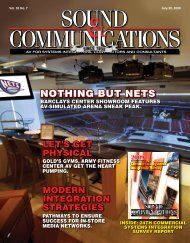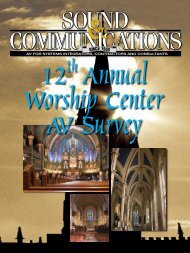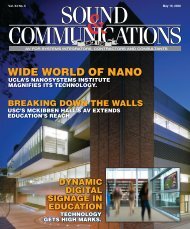Sound and Communications - February 2008 Issue
Sound and Communications - February 2008 Issue
Sound and Communications - February 2008 Issue
Create successful ePaper yourself
Turn your PDF publications into a flip-book with our unique Google optimized e-Paper software.
Attention to<br />
acoustical<br />
considerations<br />
allows trains to<br />
pass above the<br />
station’s occupants<br />
with a minimum of<br />
disturbance. Note<br />
the videowall<br />
advertising in the<br />
background.<br />
open air-wells <strong>and</strong> glass ceilings be<br />
similarly utilized. The frequent passing<br />
of both elevated <strong>and</strong> subterranean<br />
trains added to the potential noise/vibration<br />
characteristics. This was an<br />
acoustical nightmare in the making.<br />
GENEST was charged with the task<br />
of mitigating the noise/vibration concerns<br />
<strong>and</strong> taming the reverberation<br />
characteristics to a satisfactory level.<br />
ADA was expected to come up with a<br />
design that would provide speech intelligibility<br />
as dem<strong>and</strong>ed by prevailing<br />
codes within this 28,821,430-cubic-foot<br />
building, while still being unobtrusive<br />
to the architect’s visual aesthetic.<br />
Vibration Control<br />
In terms of noise/vibration control,<br />
GENEST specified that all rail tracks<br />
be laid in concrete with spring suspension<br />
<strong>and</strong> be lined with noise-absorbent<br />
materials to mitigate the rumble occasioned<br />
by train movements. Wall construction<br />
would take the form of perforated<br />
metal <strong>and</strong> concrete with layers<br />
of noise absorption materials installed<br />
behind the perforated walls.<br />
Station platforms, whenever possible,<br />
would be isolated from the main<br />
structure <strong>and</strong> be shock absorptive to<br />
reduce vibration effects. Those areas<br />
IBA Centralized Communication System Operation<br />
As implemented, the IBA system<br />
operates (in a somewhat simplified<br />
version) as follows:<br />
Note: For the following example,<br />
we will use Hbf; it being understood<br />
that similar conditions apply at all<br />
other stations.<br />
• When a train approaches Hbf,<br />
operators at the IBA Control Center<br />
are notified through an interface with<br />
the railway signaling systems that the<br />
train’s arrival is imminent. This<br />
information is displayed on the<br />
appropriate GUI by the responsible<br />
personnel. Status of the train movement<br />
on a minute-to-minute basis is<br />
essential.<br />
• When the train stops to de-train<br />
passengers, an announcement is<br />
keyed to advise passengers, “Welcome<br />
to Berlin…descend to<br />
level….For information,<br />
consult….Passengers with foreign<br />
passports proceed to….,” etc.<br />
• Waiting passengers are likewise<br />
advised, “The Berlin-Warsaw ICE is<br />
available for boarding on<br />
track….Departure time….The train<br />
will depart in five minutes….”<br />
• In the event of delays or other<br />
unusual circumstances, the operators<br />
at the IBA control center can<br />
override prerecorded messages <strong>and</strong><br />
provide timely information <strong>and</strong><br />
instructions.<br />
• The system is under constant<br />
supervision, <strong>and</strong> any equipment<br />
defaults (right down to loudspeaker<br />
line impedance) will appear as a<br />
default on the IBA system’s GUI<br />
consoles.<br />
• Trackside control stations for use<br />
by train operating personnel are<br />
available for communicating with the<br />
IBA operators when unusual circumstances<br />
dictate.<br />
• All functions are logged on<br />
control computers for analysis <strong>and</strong>/<br />
or response to specific complaints.<br />
At first glance, these sequences<br />
appear fairly uncomplicated, but<br />
multiply this one example by 1100<br />
daily arrivals/departures (one train<br />
every 30 seconds within a 24-hour<br />
time frame), <strong>and</strong> the need to route<br />
both audible <strong>and</strong> visual data to 16<br />
track zones <strong>and</strong> upward of 50 public<br />
space zones, <strong>and</strong> it becomes rather<br />
complicated.<br />
42 <strong>Sound</strong> & <strong>Communications</strong><br />
www.sound<strong>and</strong>communications.com


